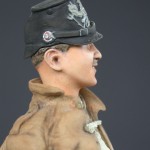
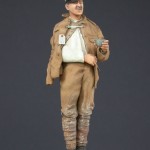
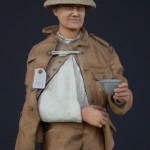
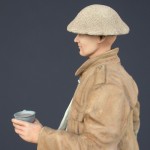
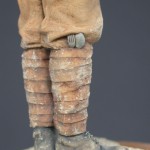
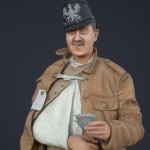
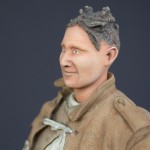
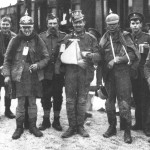
Private, Infantry Battalion, Neuve Chapelle, March 1915 – Special Offer / Bt. Infanterist, Neuve Chapelle, März 1915 – Sonderangebot
- Scale / Maßstab: 1:16
- Approx. height of figure: 118mm
- Material: Resin, Model Plaster / Modell-Gips Sockel (synethetische, kunststoffveredelte Gießmasse)
- Parts / Teile: 12
- Infosheet / Infoblatt: English
- Code: 15DIC
Contents / Inhalt:
- Figure (7 parts) / Figur (7 Teile)
- Alternative Head / 2. Kopf
- French Army Cup / französische Armee-Tasse
- Prussian Shako Model 1895 / Preußischen Tschako Modell 1895
- British Steel Helmet MK.1 / Bt. Stahlhelm Mk.1
- Figure Base / Figur-Sockel
Extracts from the Infosheet with this figure:
The figure depicts a private soldier of one of the British Infantry battalions who took part in the battle of Neuve Chapelle in March 1915. A young man, he is standing relaxed amongst similarly lightly wounded soldiers at a train station, enjoying a cup of tea, whilst sporting their different war-trophies. After being wounded he would of most probably of had to make his own way back through the combat area, either alone, or in small groups, going through the reserve and support lines to the Regimental Aid Post. Here, a quick assessment of the soldier’s condition, in this case a field dressing applied and again he would be sent back on foot approx. 1½ miles to the casualty Clearing Station (sometimes known as Advanced Dressing Station). Depending on the time available, he would have had the wound cleaned, dressed and in his case a sling applied. If he is lucky, then a motor, or horse drawn ambulance would be available to evacuate him to a Field Hospital (about 10–15 miles behind the front line), or to a rail head, where the casualties would be moved even further away from the front.
The small farming village of Neuve Chapell lies about 8 miles south west of Armentieres in northern France and was the scene of the first major British offensive of 1915. The British attacked using elements of the Regular, Territorial and Indian Army. At the battle itself, small gains were achieved, but the expected breakthrough never came about and over the 4-day period of fighting the allies suffered an estimated 12,000 casualties, of which 3,500 were fatal.
Head 1: This is the head of the soldier taken from the original photo. It depicts a young man of about 20 years old, probably a little taller than average. His teeth are slightly uneven and he has a few days growth of beard.
Head 2: This is a head from an earlier figure – Private, 4th Battalion Tank Corps, which has been slightly altered around the neck and lower jaw. The response to this figure, especially the expression on the face was good and so it has also been included as an alternative head with this figure. If one holds the head in front of a light, then it is possible to see were parts of the hair have been modelled thinly – notably the wave of hair hanging down between the left eye and ear and directly above. These thin areas can be removed using a sharp blade giving the hair an extra lightness.
Service Dress M1902: The standard battle dress of the British Army in World War 1. On account of the injured right arm, the tunic has been draped over the shoulder and held in place by a piece of bandage tied from the second button to the opposite hole. The area behind the bandage and between the cardigan can be cut away – here again the resin has been cast as thin as possible. On each side of the tunic is a brass metal support hook for the belt (on the figure only one can be seen). Beneath the shoulder straps at the front are the reinforced rifle patches. The buttons were of brass – Rifle Regiments (Light Infantry) in the British Army wore black buttons. On the tunic itself, the structure and fold of the creases follows the standard form copied from various photos of British troops in the field. It is always better when gathering reference material to use original photos of troops who have been actually wearing their uniforms for long periods of time, as most uniforms (as indeed all types of clothing, depending on the material used) will crease and fold in roughly the same way. Some reference books, especially for collectors of uniforms are helpful for colour-reference and information etc., but will not always portray an accurate picture of how the uniforms appeared after many days in the Front Line. Colour: khaki – an Urdu word meaning dusty. The dye for the material originally came from India and was made out of tea, or mud. This colour, a kind of dull brownish- yellow was more suited to the battlefields of France and Belgium than the German blue- grey. Inside the left tunic sleeve is part of the cuff of the blue-grey Army issue shirt.
Army Form W.3118 – Field Medical Card: The card label fixed to the third tunic button would have been attached during the initial treatment at the Casualty Clearing Station. On the label itself, written in lead pencil were the following details: number, rank, name, unit, wound or disease, condition (if any) requiring special treatment, the Medical Unit from which transferred and date. A red edged card was used for cases dangerously or severely wounded and who required immediate attention.
Service Dress Trousers M1902: A straight cut design, with a pocket each side and held up normally with the issued braces. The structure and fold and the creases again follows the standard form copied from various original photos of British troops in the field, i.e. slight build-up around the knees, long vertical creases at the front and large curving at the rear. Colour: khaki.
Puttees M1902: An Indian word meaning bandages. Designed to cover the gap between boot and trousers, keeping the lower leg warm and dry. The figure as in the original photo sports very uneven and untidy puttees – a result of the constant wearing in these adverse conditions. Colour: khaki (slightly more brown as in the service dress).
Ammunition Boots: The standard British Army issued boot, with steel studs in the sole. From 1918 a new type of boot was issued with a reinforced sole and toecap. The figure is wearing the early type of boot. These boots were by no means waterproof and with prolonged exposure to dampness and cold in the trenches there had to be regular foot inspections carried out by unit, or R.A.M.C (Royal Army Medical Corps) officers. Colour: black.
Prussian Shako Model 1895 / Preußischen Tschako Modell 1895: The standard Prussian shako for other ranks, worn by Jäger and Schützen Regiments, along with other units including Machine-gun detachments, Telegraph – Signal, Air Service (including Airship) detachments. Up to 1854 Jäger battalions had worn the Pickelhaube and it was not until the 1950s that the last shakos were issued to the West German Police. As the war progressed and particularly after 1916, front line troops were issued the steel helmet and shakos were seldom seen. Made out of black painted leather with the seam running down the front behind the helmet plate badge. The helmet form tapered slightly towards the top and the rear was shaped to the head. It had an oval leather top stitched to the body, with gloss black painted brass vents directly underneath, at the sides, each with 6 holes. The front and rear visors were made out of thick leather and had a black polished finish. As always being an other-ranks helmet, this would have had the standard leather chinstrap with two adjustable brass (later matt grey painted steel) buckles. On the right of the helmet, behind the chinstrap are the national Reichsfarben: black, white and red (from outwards to the centre). Behind the side posts, between the visors are the leather reinforcements. The helmet plate is the Prussian line eagle, bearing the inscription Mit Gott Für König und Vaterland – With God for King and Fatherland – and the letters FR standing for Fridericus Rex (Fridericus Rex – Latin – King Friedrich. This was King Friedrich II, or in the German spelling König Friedrich der Große). The eagle holds the Zepter – mace with a small eagle on top – and the Reichsapfel – orb (globe mounted by a cross). The metal used depended on the colour of the tunic buttons, but would have been either Tombak (Tombak – an alloy of copper and zinc, which had a matt bronze/yellow colour), or Neusilber (Neusilber- German silver – argent. An alloy of zinc, copper and nickel, similar to the colour of aluminium). From 1915 onwards all helmet plates were produced in iron, or steel and painted matt grey. Normally a wooden cloth covered field badge approx 62mm high with the Prussian white and black colours is attached to the top of the helmet. These of course, like the Pickelhaube spike were quickly removed in the first months of the war. The natural leather interior had a 9-finger liner tied in the middle with a cord.
Fork and Spoon: He has pushed his fork and spoon into the top of the puttees, probably for an easy, quick access. As a knife he would of most probably have used his issued pocket-knife, which was kept in one of the tunic pockets. Colour: dull silver (tin-plated).
The Base: The base supplied with the figure depicts a section of gravel platform, typical of one of the nearby railway stations close to the battle behind the British line.
 An deutschsprachige Interessenten:
Sie können mich per eMail oder Telefon auch gerne auf deutsch kontaktieren. Ortsbesuch ist nach Absprache möglich.
An deutschsprachige Interessenten:
Sie können mich per eMail oder Telefon auch gerne auf deutsch kontaktieren. Ortsbesuch ist nach Absprache möglich.
